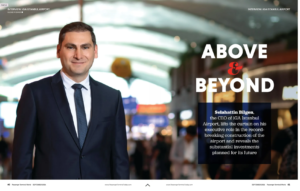Selahattin Bilgen, the CEO of iGA Istanbul Airport, lifts the curtain on his executive role in the record-breaking construction of the airport and reveals the substantial investments planned for its future.
Please tell us about your career to date.
I actually started my career as a banker at a local bank in Turkey, which was partly owned by UniCredit. After that, I transitioned to UniCredit itself, focusing on corporate investment banking. In that role, I was responsible for infrastructure financing for a long time and eventually became a managing director within the group. My work frequently involved infrastructure financing schemes, often related to airports, which enabled me to gain a detailed understanding of and interest in the airport business.
Later, I received a job offer from the shareholders of the iGA Istanbul Airport project to join the team responsible for financing the project at the initial stage of the government tender. After working for one of the shareholders for three-and-a-half years, I became the chief financial officer of iGA. I served as CFO for more than six years, and last September I assumed the role of CEO. For the first six months, I was the acting CEO. Then, in April 2024, my position became permanent. Therefore, I’ve been with the iGA Istanbul Airport project since its inception.
What are some of the challenges you face as CEO in your day-to-day role?
iGA Istanbul Airport began as one of the largest startups not just in Turkey but globally. When I started, we had only seven key employees. Now we have more than 12,000; during the construction period it peaked at 43,000. Initially, we operated like a startup to meet the challenging investment timeline, and after opening we had to be resilient during the Covid-19 crisis. This startup mentality has made us agile, ensuring we can react and adapt quickly. However, as we have grown into a large-scale corporate entity, we now face the challenge of defining processes and building a corporate structure that sustains our operations without losing our agility. Our company culture is unique, blending airport operations with a startup’s dynamism and a large investment company’s expertise. Professionals from various backgrounds contribute to this culture, bringing diverse perspectives and expertise. Managing this diversity and maintaining our ability to adapt quickly while also building a robust corporate structure are key aspects of my role.
“When I started, we had only seven key employees. Now we have more than 12,000”
How does sustainability factor into your operation of iGA Istanbul Airport?
My focus has always been on creating a sustainable airport. Indeed, iGA Istanbul Airport has committed to being carbon neutral by 2050; last year we were already 14% ahead of our targets for 2023. This was made possible by designing the airport from scratch. Although challenging, this enabled us to prepare for the future using the latest technologies. As a result, iGA Istanbul Airport is the largest building in the world with a LEED Gold certification – not just the largest terminal. Additionally, 30% of our water is sourced from our roof.
We’ve also implemented high-tech and automation systems to improve our operations. For example, even though passenger numbers increased by 18% last year, our electricity consumption decreased by 11%.

Alongside this, we are investing in a 3,000,000m2 solar power plant (SPP) to meet the entire airport ecosystem’s electricity needs, not just those of iGA Istanbul Airport but also those of all stakeholders within the airport ecosystem. Through this initiative, we aim to minimize Scope 3 emissions as well.
Please tell us more about the iGA Istanbul Airport project and iGA Istanbul Airport’s €656.5m ‘year of investments’.
The iGA Istanbul Airport project is one of the largest development projects in the world. Since the beginning, the project has required significant investments due to our contractual obligations to the government. It’s unique because we managed to transfer all the operations of a large airport (Ataturk Airport) to iGA Istanbul Airport in just 33 hours back in 2019. This feat required a high level of planning, not only for the airport transfer but also for the massive amount of construction work involved. iGA Istanbul Airport now aims to be a major global hub. On the operations and business development side, we’ve been working hard to achieve this.

So far, the project has proved to be highly successful. iGA Istanbul Airport has been the busiest airport in Europe for four consecutive years in terms of air traffic movements. Globally, we are the most connected airport, serving more than 316 destinations and hosting 107 airlines regularly. This achievement places us among the top three airports in the world.
One key enabler for this growth is our strategic location between Africa, Europe and Central Asia, though we are currently under-serving the Far East, Asia-Pacific and US markets. For this reason, iGA Istanbul Airport’s €656.5m [US$706m] ‘year of investments’ is highly focused on penetrating these untapped markets and enhancing point-to-point traffic growth in Turkey.

Specifically, we plan to increase the number of flights to 532,000 and reach 85 million passengers in 2024. To support this growth, iGA plans to complete the €35m [US$37m] General Aviation Terminal at the end of 2024, and the €25.6m [US$27.5m] Hilton Istanbul Airport in the first quarter of 2025.
Looking to the future, where do you see the most potential for growth, and how do you plan to achieve it?
We still have significant potential to grow further. Our business plan and masterplan both provide us with clear visibility for the future so we know exactly what to invest in and when.
Overall, our investment plan is divided into four phases, each triggered by specific thresholds such as passenger numbers and air traffic movements. This clear roadmap lets us know when to start new investments, and their scale. This masterplan will increase flight frequencies, expand the number of destinations we offer and boost our passenger capacity to up to 200 million passengers. We’ve completed the initial phase, which was the largest, with an investment of €7.2bn [US$8bn] out of our overall €10.2bn [US$11.3bn] investment commitment. This phase included constructing the world’s largest terminal building, which covers approximately 1,400,000m2, as well as three independent parallel runways and two ancillary runways, the world’s largest airport parking garage and more than 200 other buildings. This initial phase was completed within 42 months, on time and on budget.

Despite the scale of the initial phase, future phases aim to increase our infrastructure to nine runways (six main and three ancillary) and two terminal buildings. This expansion will ultimately give us the capacity to serve 200 million passengers. So, we have come a long way, but there’s still a way to go. We are working hard to cover the underserved markets and futureproof our operations.
We are now running the Phase 2 investments, which include adding another main runway, an ancillary runway and increasing the existing terminal’s passenger capacity from 90 million to 120 million.
Additionally, we are making investments beyond our contractual obligations to enhance operational efficiency, sustainability and commercial viability. For example, our solar power plant project, although not mandatory, was decided by the iGA Istanbul Airport management to increase efficiency and support sustainability goals. We are also heavily investing in people, tech and customer experience. Our airport has been designed to enable a contactless journey from entry to boarding, although some implementations depend on regulatory approvals and the integration of other stakeholders.

“It’s not just about market share but about expanding the market size”
Our strategy aligns with the country’s tourism strategy, and we believe the future of the sector depends on the collective actions of all stakeholders. If we operate efficiently, meet passenger demands, provide a smooth experience and fulfill sustainability requirements, the sector’s growth potential is extremely high. If we meet these needs, the desire to travel and the use of air cargo should remain strong. Additionally, increasing cooperation and data sharing between stakeholders will make it easier to grow the market overall. It’s not just about market share but about expanding the market size by improving efficiencies, sustainability and passenger experience.
What advice would you give to a new airport CEO on how to navigate the challenges ahead?
It depends on the specific airport, but iGA Istanbul Airport has set its own example in many ways. The main advice I would offer is to maintain a balance between agility and corporate stability. Starting with a clear, long-term vision and having the ability to quickly adapt to changing circumstances are crucial. It’s also essential to focus on collaboration within the sector, whether it’s sharing data or working closely with stakeholders to enhance operational efficiency. Finally, sustainability and passenger experience should be at the core of all operations. If these elements are prioritized, the potential for growth remains significant, even in challenging times.
This article originally appeared in the September 2024 issue of Passenger Terminal World. To view the magazine in full, click here.



